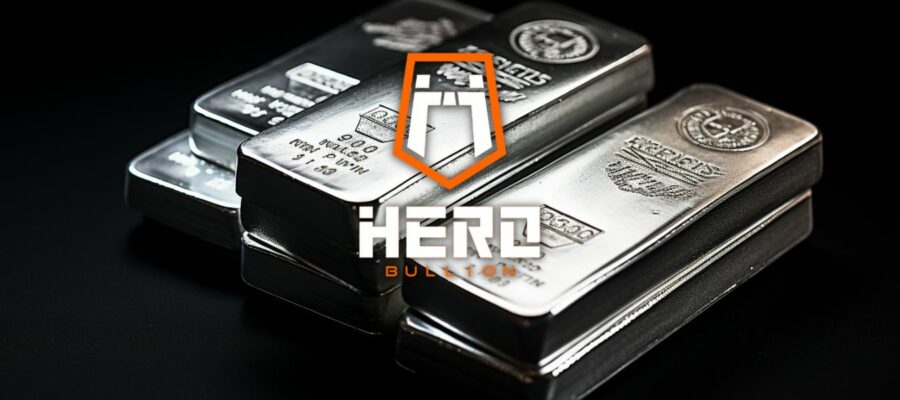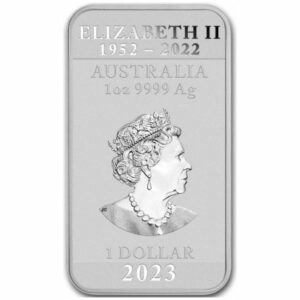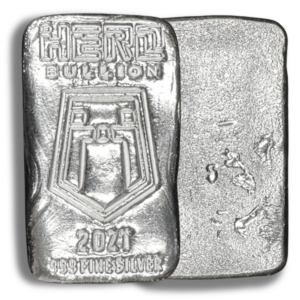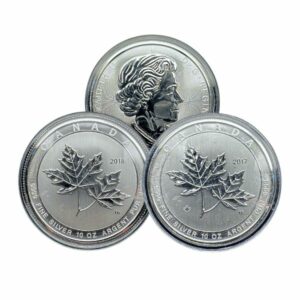How to Sell Silver Bars

Whether you need the cash for an unexpected expense or it’s time to liquidate to fund a new investment, selling silver bars is an excellent way to make some extra cash. But even seasoned investors sometimes struggle to navigate the bullion marketplace and get the most money for their silver products. Hero Bullion is always happy to help. After all, selling your silver bars is a good way to raise capital to buy other silver products like pure silver coins.
Today, we’ll be covering some of the most important steps involved in selling bullion silver bars. While it might seem simple on the surface, there are actually quite a few things that the average seller should keep in mind before they finally receive payment for their silver. After all, the last thing any silver investor wants is to get ripped off when it finally comes time to capitalize on their hard-won silver stockpile. Many new bullion investors ask us how to sell silver bars, so we’ve put together a helpful guide to the process.
Assessing Your Silver Bars
The first step in selling silver bars will always involve assessing quality and condition. Buyers won’t want to do business with someone who doesn’t understand the value and pristineness of their items. Don’t worry – it’s actually pretty easy to assess your silver bars before selling them.
Understanding, Purity, Weight, and Condition
Not all silver bars are created equal. While most silver bars contain .9999 pure silver bullion and are valued primarily for precious metal content, others are less pure. Your bars might also become damaged over time, especially if you haven’t kept them in safe, secure conditions. Evaluating silver content, weight, and condition is an essential part of the selling process.
Once you know your silver bars are genuine, assessing purity and weight should be an easy process. Most silver bars include this information on either the front or back. Take a close look at the inscriptions on your bar to figure out how pure your bar is, as well as how much it weighs.
Silver bars in good condition should also be free from scratches, scuff-marks, or other forms of damage. In other words, a silver bar in the best possible condition should look just as it did the day you bought it.
Researching Market Demand and Current Silver Prices
Buyers are frequently looking for unaware sellers who they can scam easy profit out of. To avoid losing money on your investment or being low-balled for your silver bar, carefully research market demand and identify silver prices. The more up-to-date your understanding of market trends is, the better price you’ll be able to secure during your sale.
When demand for silver is high, prices tend to increase for silver bullion products. Silver’s price is tracked by its spot price, which is the current value of silver per troy ounce. Websites like the Silver Institute also track silver demand over time to give consumers a better idea of how desperate buyers might be for silver bullion.
Finding Buyers for Silver Bars
For new bullion sellers, finding the right buyer is often an overwhelming task. Luckily, there are several places you can look to find the right place to find your next silver buyer.
Local Dealers and Coin Shops
Local dealers might be your first place to look to sell silver bars. Pawn shops are certainly an option, but we recommend looking for specialized bullion dealers instead. As their reputation suggests, pawn shops might not offer top-dollar for your silver products. We tend to prefer that sellers look for local, popular bullion dealers in their area to get a quote and sell their products for a fairer price.
Coin shops might also buy silver bullion bars. Stores near you that sell silver and gold coins could offer a higher price for your silver bars than some major online marketplaces. A quick search online should help you find the top-rated local coin dealers and bullion buyers in your area.

Online Platforms and Marketplaces
In the age of the internet, it’s never been easier to sell bullion bars for fair prices. Many online bullion distributors offer buyback programs, and savvy sellers can negotiate with their buyer to get the most out of their silver bars. There are also marketplaces specifically designed for buying and selling silver, such as Bullion Universe.
Before you choose an online marketplace, make sure that the company has procedures in place to ensure the safety and security of both buyers and sellers. Good companies to do business with don’t just know how to sell silver bars – they know how to buy at fair, reasonable prices.
Preparing for Sale
Sales of bullion products rarely happen overnight. While long-term investors with solid investment plans understand how to sell silver bars, they sometimes might not be ready for the complicated process of actually securing their hard-earned profit. If you’re not careful, selling even a single silver bar can be a headache. To avoid this, sellers should work before the sale to make sure they have everything they need for a successful exchange.
Cleaning and Handling Silver Bars Carefully
You probably already know how important it is to keep your silver bars in pristine condition. Some sellers lose money for themselves by improperly cleaning and handling their silver bars before shipment or sale. Don’t throw your hard-earned investment profit away – make sure you’re cleaning your bars thoroughly but carefully to avoid damage.
To clean your silver bars, experts recommend using distilled water. Pouring anything but distilled water on your bar could cause the liquid’s minerals to mark and damage your bar, which decreases sale value. If your silver bar has been tarnished with time, using a bit of baking soda can help to take the tarnish away. Most sellers clean their silver bars by submerging them in hot distilled water and adding baking soda to the top. Allowing the silver to soak takes away nasty tarnish without risking damage to the silver bar.
Collecting Relevant Documentation
If your silver bar came with an assay card or any certificate(s) of authenticity, be sure to keep those with you. While many consumers don’t think about proper storage for these non-bullion documents, we recommend keeping them in a dry place to avoid any kind of water damage. These certificates can go a long way to assure your buyer that their new silver bar is legitimate and genuine silver.
Choosing a Selling Method
There are multiple ways for you to sell your silver. We’ll cover three in this section: selling to local dealers, listing on online platforms, and exploring auction options.
Selling to Local Dealers or Shops
Local dealers might not always offer the best price for your silver bars, but it might be more assuring to sell your product in-person to a buyer near you. Look around for reputable coin and bullion dealers and find one that offers to buy silver. We highly recommend going to multiple different buyers to compare prices. After all, you want to get as much money as possible from your silver, and the first shop’s price may not be good enough!
Listing on Online Platforms
If local dealers don’t give you the offer you’re looking for, listing your silver bars on an online marketplace might be a viable option. Online marketplaces might require less work than driving back and forth between multiple local dealers, but the signup process and authenticity proof procedures could be difficult. Silver bar sellers should always carefully vet online marketplaces to make sure that they have protections in place for both buyers and sellers. Bullion dealers like Hero Bullion help you understand how to sell silver bars – and we even offer a buyback program for precious metal products like silver bullion bars.
Marketplaces without these protections might leave sellers high and dry in the case of scamming. A bounced check, for example, becomes a major risk if a company fails to integrate an effective escrow system on their online marketplace. It shouldn’t be hard to understand how to sell silver bars, but the large number of sketchy bullion dealers makes it tough to liquidate your investment with confidence. If you already know the basics of how to sell silver bars, secure your investment’s profitability by carefully avoiding unfair buyers and lowball prices.
Exploring Auction Options
Some sites actually allow sellers to auction their silver bars. If you don’t know what your silver bullion bar is worth, this might be a decent option. Sellers might also make more from auctioning their silver than if they had sold it, although this certainly is not guaranteed. Popular auction sites like eBay are worth exploring, but we recommend websites that specialize in bullion products. eBay’s coverage for sellers might be harder to cash-in on than the protections on a popular bullion-specific auction site. “How to sell silver bars” is a common question. To figure out which buyer is best for your silver bars, take a close look at auction options.

Negotiating the Selling Price
If you’re selling your product using a buyback program at a reputable bullion dealer, negotiation might not be a huge part of the sales process. However, there still may be room for you to negotiate a better deal when selling your silver bars, especially if you choose to deal with a small or local bullion dealer.
Considering Spot Price and Market Trends
Are silver products really worth money once you know how to sell silver bars? Of course! But the exact value of your silver coin depends on a number of factors, including both the spot price of silver and prevailing market trends. Supply and demand, a law of classical economics, influences what buyers should expect to pay for silver – as well as what sellers should expect to charge for their product.
Carefully evaluate current market conditions in the silver sector to make sure your selling price is close to what other sellers are asking for similar silver items. Don’t worry if you aren’t quite an expert on silver spot prices. Even seasoned investors have questions about how to sell silver bars, and understanding the right time to sell given market conditions can be a real task.
Factoring in Brand or Rarity Premiums
How do you sell silver at market value? The first step is to consider spot price, but spot price isn’t the only thing that influences the value of your silver bar. Silver bars from popular mints, or bars that were printed in limited numbers, might be exceptionally valuable. If you don’t do research and determine how much numismatic value is contained in your silver bar, you might not be getting as much money as you should for your product. When investors ask how to sell silver bars, they need to be aware of the brand and rarity of their products before looking for a buyer.
Negotiating and Finalizing the Sale
If the buyer you sell your silver bar to allows for negotiation, your goal is to get as close to the spot price of silver as possible while still being compensated for the collectible value of your silver bar.
Presenting Bars to Potential Buyers
When you present a silver bar to your buyer, you should make sure that it is as clean and undamaged as possible. Accurately describing the condition of your bar is important, especially if you plan to sell your bar using an online marketplace. If your bar came in a collectible case or with a certificate of authenticity, including this with your sale could increase the total value of your silver bar.
Negotiating Terms and Price
Sellers should always try to get the most out of their item. When our readers try to figure out how to sell silver bars, the savviest future investors take time to negotiate the terms and price of their sale. You paid for the silver, and you want to profit as much as you can when it’s finally time to sell your investment. When negotiating the terms of your sale, collect as much data about current market conditions as possible. If your buyer offers too little, don’t be afraid to negotiate for a closer value to the spot price of your item.
You’ll likely never get an offer for 100% of the spot price value of your silver bar, but it’s reasonable to negotiate up to 75 or even 85 percent of the total market value. As with any sale, it’s important to be respectful and honest during the negotiation process, and we recommend going into price negotiations with a deep understanding of the actual value of your silver bar.
Payment and Delivery
After the sale has been finalized, the only steps left are to deliver the product and collect payment. “How to sell silver bars” is a common concern investors bring us, but far too few sellers come prepared with an understanding of how to actually accept payment and deliver their silver. Payment details will vary based on the buyers you choose to do business with, but sellers should always make sure that they understand how, and when, payment for their silver will be rendered.
Secure Payment Details
Most online marketplaces should use a secure escrow system to facilitate sale between individuals. Many major online dealers with buyback programs offer secure payment processing. If you’re unsure about the process, ask your buyer how they plan to render payment for your silver bar during negotiation.
Safe and Insured Shipping, if Applicable
The sale isn’t done after you’ve received payment. If you’re selling to someone local, shipment isn’t a concern. But online marketplace deals require you to ship your products. This can be costly, so be sure to factor the cost of shipping into the total sale price of your item. When shipping your silver bars, you’ll need to research packing strategies to ensure that the product isn’t damaged in transit.
Post-Sale Considerations
If you’re wondering about how to sell silver bars without ending up with a loss, make sure to check out our guidelines for what sellers need to do after the sale is over. Especially in an online marketplace, selling silver comes with several post-sale obligations. In this section, we’ll cover the things that you need to do after selling your silver bar.
Documenting the Sale for Tax Purposes
Depending on the amount of silver you sell, you may be obligated to pay additional taxes at the end of the fiscal year. In the United States, it is not necessary to file a 1099-B form for any silver bars sold that are less than 1,000 troy ounces in weight. These products still need to be included as income on Schedule D of the 1040 form when you file your taxes, however. Asking how to sell silver bars is a good place to start, but investors with a solid investment plan should also know how to deal with the tax obligation after sale.

Evaluating Selling Experience and Feedback
It’s common courtesy to leave feedback for your buyer. This can be done whether you deal with a local buyer or an online marketplace. As you continue to buy and sell silver bullion, establishing a reputation for fair dealings and solid communication can go a long way in establishing buyer confidence.
We recommend being honest but respectful in your feedback.
Reviewing Investment Strategy
Selling a silver bar is a good time to evaluate and review your investment strategy. You can use the sale of silver bars to track how profitable your investment strategy has become over time. After you understand how to sell silver bars, the next step is to determine how you’ll move forward in your long-term investing plan. Sometimes, we might lose money after selling our silver bullion products. When this happens, it might be necessary to reevaluate our portfolio-building strategies to ensure better profit in the future.
Final Thoughts: Selling Silver Bars
Selling silver bars may seem complicated, but it doesn’t have to be. You’ve worked hard to build a collection of pure silver bars, and you deserve a stress-free process when cashing out! To ensure you get the most out of your investment, refer back to this guide whenever you need to.
Interested in selling your silver bars? Give our customer service team a call anytime to receive more information about Hero Bullion’s buyback program.
About The Author
Michael Roets
Michael Roets is a writer and journalist for Hero Bullion. His work explores precious metals news, guides, and commentary.
